After a long workday, coming home to a wagging tail or a comforting purr is one of the benefits of having a four-legged companion. Many pet owners also enjoy slobbery smooches from their pet, and it’s likely you have turned your head away at times because of their unpleasant breath. While a lot of pet owners believe bad breath is normal for their pet, in reality, it can be the first clue they have some form of dental disease. More than 80% of pets will have signs of dental disease by the time they are 3 years old. Our Marcy Veterinary Clinic team wants your pet’s smile to always sparkle, so we discuss steps to ensure they are on the right dental health track.
#1: Schedule regular preventive care visits for your pet
Yearly, or more frequent, veterinary examinations will ensure your pet’s health is closely monitored throughout their life. However, preventive care involves more than vaccinations and parasite control. Your veterinarian will perform a nose-to-tail exam, including an oral examination, and discuss your pet’s lifestyle, diet, and behavior, which provide clues about oral health. Periodontal disease, which occurs from inflammation and infection of the soft tissue structures around the teeth, is the most commonly diagnosed dental problem in pets. Like humans, pets are affected by plaque after each meal. The plaque builds up and hardens into a cement-like tartar that allows bacteria to become trapped in and around the gumline, and is a common cause of bad breath. Trapped oral bacteria have a direct line to the bloodstream and can travel through the body, affecting your pet’s organs, including their kidneys, liver, lungs, heart, and brain. If your pet has tartar, bad breath, or other dental problems, such as a broken tooth, a professional dental cleaning is recommended.
#2: Learn to recognize dental disease signs in your pet
It can be challenging for pet owners to know when their pets are suffering from painful dental disease, because it most often occurs below the gumline. Additionally, many pets, especially cats, are skilled at hiding signs of illness or discomfort. Make an appointment for your pet with their veterinarian if they have any of these common dental disease signs:
- Bad breath
- Excessive drooling
- Abnormal or difficulty chewing
- Irritability or increased hiding in cats
- Dropping food from the mouth while eating
- Decreased appetite
- Refusal or reluctance to take hard treats
- Swollen or red gums
- Swelling around the mouth or cheeks
- Nasal discharge
- Bleeding from the mouth
- Blood on chew toys
- Pain when touching the mouth or face
#3: Schedule your pet for a professional dental cleaning
A professional dental cleaning under anesthesia is the safest, most effective, and stress-free method to examine and clean your pet’s teeth. Before your pet’s dental procedure, your veterinarian will run pre-anesthetic blood work to ensure your pet does not have any underlying health issues. In some cases, a chest X-ray also may be recommended to ensure it is safe for your pet to undergo anesthesia. Your pet will be closely monitored during all stages of their dental cleaning, which includes:
- Dental X-rays to examine teeth below the gumline
- Mapping and charting of their teeth (i.e., gentle probing around each tooth to look for pockets or infected teeth)
- Cleaning with specialized tools, including an ultrasonic scaler
- Polishing with a fluoride-infused polish to prevent plaque buildup
- Extracting loose or damaged teeth
#4: Start a home dental care routine for your pet
Proper pet dental care is a team effort between you and your family veterinarian. Incorporating a home dental care plan into your pet’s routine is vital to prevent dental disease progression between regular veterinary visits and professional dental cleanings. Although twice daily toothbrushing is the gold standard, it can be challenging to do this. According to the National Pet Dental Health Association, brushing your pet’s teeth at least three times a week is beneficial. Consistency and patience are key, and a routine that is realistic and manageable is best. However, never force your pet to accept toothbrushing. If your pet is resistant, consider Veterinary Oral Health Council (VOHC)-approved dental chews, treats, or rinses to improve their oral health. Other guidelines include:
- Choosing a pet-safe toothpaste approved by the VOHC. Never give your pet human toothpaste because most include ingredients that are toxic to pets.
- Starting by offering your pet toothpaste on your finger as a treat or reward. Once your pet is comfortable, put the paste on your finger and gently rub it over their gums and teeth in a brushing motion.
- Choosing a pet-specific or children’s toothbrush that fits comfortably in your pet’s mouth. Allow your pet to investigate the brush before putting it in their mouth.
- Using generous verbal praise and belly rubs during and after each toothbrushing session.
Call our Marcy Veterinary Clinic office if you have questions about your pet’s dental care, or to schedule an appointment for their preventive care examination.








Leave A Comment